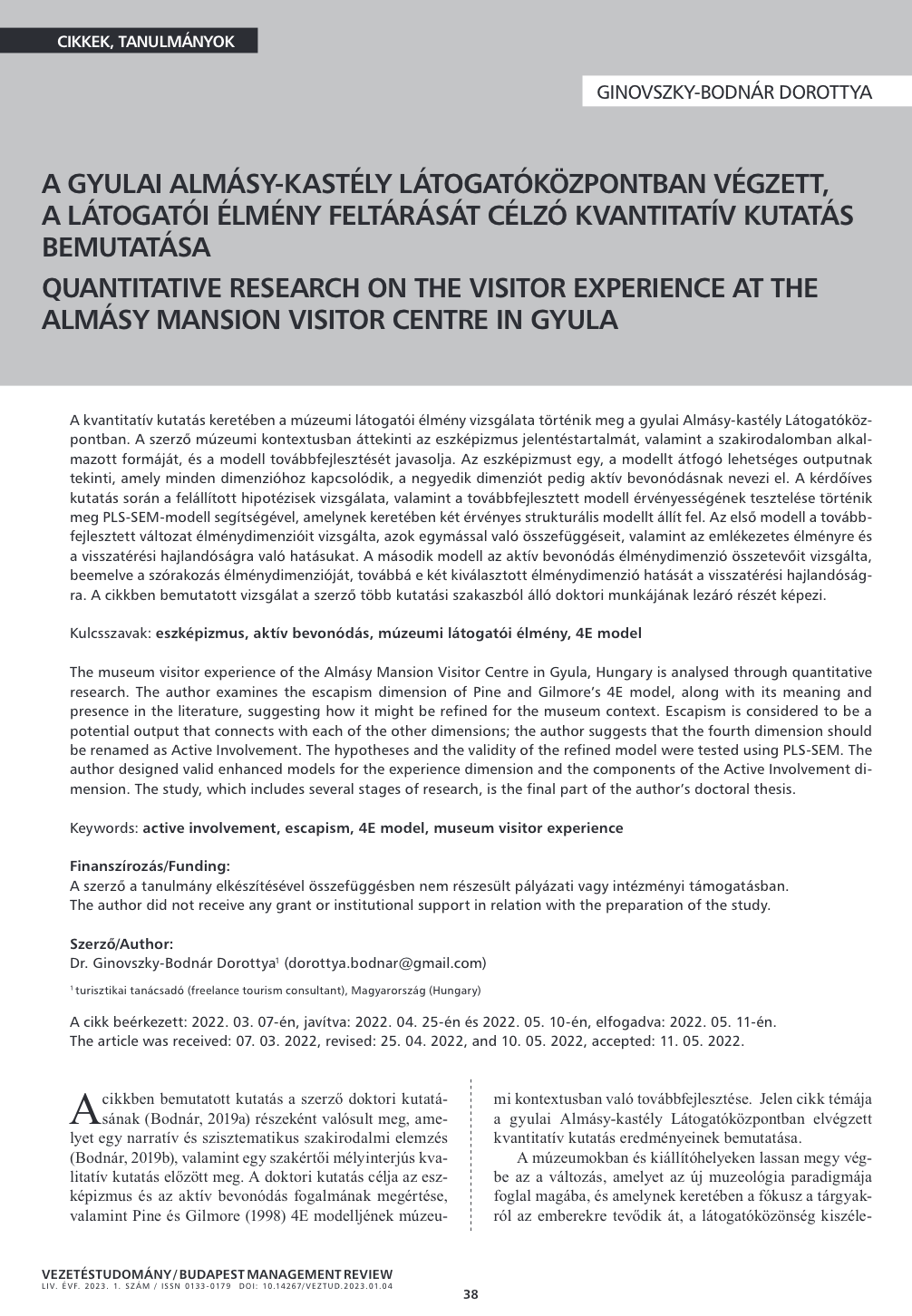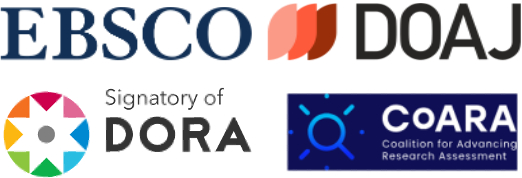A gyulai Almásy-kastély Látogatóközpontban végzett, a látogatói élmény feltárását célzó kvantitatív kutatás bemutatása
DOI:
https://doi.org/10.14267/VEZTUD.2023.01.04Kulcsszavak:
eszképizmus, aktív bevonódás, múzeumi látogatói élmény, 4E modelAbsztrakt
A kvantitatív kutatás keretében a múzeumi látogatói élmény vizsgálata történik meg a gyulai Almásy-kastély Látogatóközpontban. A szerző múzeumi kontextusban áttekinti az eszképizmus jelentéstartalmát, valamint a szakirodalomban alkalmazott formáját, és a modell továbbfejlesztését javasolja. Az eszképizmust egy, a modellt átfogó lehetséges outputnak tekinti, amely minden dimenzióhoz kapcsolódik, a negyedik dimenziót pedig aktív bevonódásnak nevezi el. A kérdőíves kutatás során a felállított hipotézisek vizsgálata, valamint a továbbfejlesztett modell érvényességének tesztelése történik meg PLS-SEM-modell segítségével, amelynek keretében két érvényes strukturális modellt állít fel. Az első modell a továbbfejlesztett változat élménydimenzióit vizsgálta, azok egymással való összefüggéseit, valamint az emlékezetes élményre és a visszatérési hajlandóságra való hatásukat. A második modell az aktív bevonódás élménydimenzió összetevőit vizsgálta, beemelve a szórakozás élménydimenzióját, továbbá e két kiválasztott élménydimenzió hatását a visszatérési hajlandóságra. A cikkben bemutatott vizsgálat a szerző több kutatási szakaszból álló doktori munkájának lezáró részét képezi.
Letöltések
Hivatkozások
Alsawafi, A. M. (2017). Sport tourism: an exploration of the travel motivations and constraints of Omani tourists. Anatolia, 28(2), 239-249. https://doi.org/10.1080/13032917.2017.1308388
Arnould, E. J., Price, L., & Zinkhan, G. (2002). Consumers. New York: McGraw-Hill.
Ásványi, K., Jászberényi, M., & Bodnár, D. (2017). Egy budapesti múzeum az élményvágyó kulturális turista szemében. In Bányai, E., Lányi, B., & Törőcsik, M. (Eds.), Tükröződés, társtudományok, trendek, fogyasztás. EMOK XXIII. országos konferencia tanulmánykötete (pp. 5-13.) Pécs: Pécsi Tudományegyetem Közgazdaságtudományi Kar.
Ásványi, K., Fehér, Zs., & Jászberényi, M. (2021). The Family-Friendly Museum: Museums through the eyes of families. Muzeologia a Kulturne Dedicstvo - Museology and Cultural Heritage, 9(1), 21-40. https://doi.org/10.46284/mkd.2021.9.1.2
Ásványi, K., Mitev, A., Jászberényi, M., & Mert, M. (2019). Családok fesztiválélménye – két családbarát fesztivál elemzése. Turizmus Bulletin, 19(3), 30-37. https://doi.org/10.14267/TURBULL.2019v19n3.4
Bodnár, D. (2019a). Látogatói élmény a múzeumokban. Az eszképizmus mint élménydimenzió elemzése a múzeumi látogatások kontextusában (Doktori értekezés). Budapesti Corvinus Egyetem, Gazdálkodástani Doktori Iskola, Budapest. https://doi.org/10.14267/phd.2020004
Bodnár, D. (2019b). Esapism or active involvement: A dimension of museum visitor experience. Vezetéstudomány, 50(11), 18-36. https://doi.org/10.14267/VEZTUD.2019.11.02
Bonn, M. A., Joseph-Mathews, S. M., Dai, M., Hayes, S., & Cave, J. (2007). Heritage/culture attraction atmospherics: Creating the right environment for the heritage/cultural visitor. Journal of Travel Research, 45(3), 345-354. https://doi.org/10.1177/0047287506295947
Boorstin, D. (1964). The Image: A Guide to Pseudo-Events in America. New York: Harper.
Bradburne, J. M. (2002). Museums and their languages: Is interactivity different for fine art as opposed to design? paper presented on Interactive Learning in Museums of Art and Design. 17–18 May 2002, London. http://media.vam.ac.uk/media/documents/legacy_documents/file_upload/5758_file.pdf
Crozier J. M. (2012). Innovation at heritage tourist attractions (Unpublished PhD thesis). Tasmania: University of Tasmania. https://eprints.utas.edu.au/14750/
Dijkstra, T. K., & Henseler, J. (2015). Consistent partial least squares path modeling. MIS Quarterly, 39(2), 297-316. https://doi.org/10.25300/MISQ/2015/39.2.02
Dirsehan, T. (2012): Analyzing museum visitor experiences and post experience dimensions using SEM. Bogazici Journal: Review of Social, Economic & Administrative Studies, 26(1), 103-125. https://doi.org/10.21773/boun.26.1.6
Dolcos, F., & Cabeza, R. (2002). Event-related potentials of emotional memory: Encoding pleasant, unpleasant, and neutral pictures, cognitive. Affective & Behavioral Neuroscience, 2(3), 252–263. https://doi.org/10.3758/CABN.2.3.252
Eardley, A. F., Mineiro, C., Neves, J., & Ride, P. (2016). Redefining access: Embracing multimodality, memorability and shared experience in Museums. Curator: The Museum Journal, 59(3), 263-286. https://doi.org/10.1111/cura.12163
Falk, J. H. (2009). Identity and the museum visitor experience. Walnut Creek: Left Coast Press. https://doi.org/10.4324/9781315427058
Falk, J. H., Scott, C., Dierking, L., Rennie, L., & Jones, M. C. (2004). Interactives and visitor learning. Curator: The Museum Journal, 47(2), 171-198. https://doi.org/10.1111/j.2151-6952.2004.tb00116.x
Fehér, Zs., Ásványi, K., & Jászberényi, M. (2021). Fenntartható múzeumok az európai régiókban. Északmagyarországi Stratégiai Füzetek, 18(3), 92-102. https://doi.org/10.32976/stratfuz.2021.44
Forgas-Coll, S., Palau-Saumell, R., Matute, J., & Tárrega, S. (2017). How do service quality, experiences and enduring involvement influence tourists’ behavior? An empirical study in the Picasso and Miró museums in Barcelona. International Journal of Tourism Research, 19(2), 246-256. https://doi.org/10.1002/jtr.2107
Fornell, C., & Larcker, D. F. (1981). Evaluating Structural Equation Models with unobservable variables and measurement error. Journal of Marketing Research, 18(1), 39–50. https://doi.org/10.2307/3151312
Goulding, Ch. (2000). The museum environment and the visitor experience. European Journal of Marketing, 34(3-4), 261-278. https://doi.org/10.1108/03090560010311849
Gram, M. (2005). Family holidays. A qualitative analysis of family holiday experiences. Scandinavian Journal of Hospitality and Tourism, 5(1), 2-22. https://doi.org/10.1080/15022250510014255
Gross, E. (1961). A functional approach to leisure analysis. Social Problems, 9(1), 2–8. https://doi.org/10.2307/799417
Hair, J. F., Sarstedt, M., Ringle, C. M., & Mena, J. A. (2012). An assessment of the use of partial least squares structural equation modeling in marketing research. Journal of the Academy of Marketing Science, 40(3), 414–433. https://doi.org/10.1007/s11747-011-0261-6
Harrison, P., & Shaw, R. (2004). Consumer satisfaction and post-purchase intentions: an exploratory study of museum visitors. International Journal of Arts Management, 6(2), 23-32.
Hjalager, A. M. (2010). A review of innovation research in tourism. Tourism Management, 31(1), 1–12. https://doi. org/10.1016/j.tourman.2009.08.012
Hooper-Greenhill, E. (1999). Museums: ideal learning environment. Museums and their visitors. London: Routledge.
Hu, L. T., & Bentler, P. M. (1999). Cutoff criteria for fit indexes in covariance structure analysis: Conventional criteria versus new alternatives. Structural Equation Modeling, 6(1), 1-55. https://doi.org/10.1080/10705519909540118
Jarrier, E., & Bourgeon-Renault, D. (2012). Impact of mediation devices on the museum visit experience and on visitiors’ behavioural intentions. International Journal of Arts Management, 15(1), 18-29. https://hal.archives-ouvertes.fr/hal-02139835/document
Jegers, K., & Wiberg, C. (2003). FunTain: Design implications for edutainment games. In Proceedings of ED-MEDIA 2003. Charlottesville: Association for the Advancement of Computing in Education. http://www8.informatik.umu.se/~colsson/shortjegwib.doc.pdf
Kulcsár, N. (2015). A fogyasztói érték és az élmény kontextusa a turisztikai szakirodalomban. Vezetéstudomány, 46(3), 18-25. https://doi.org10.14267/VEZTUD.2015.03.02
Lai, M. K. (2015). Universal scent blackbox: engaging visitors communication through creating olfactory experience at art museum. In Proceedings of the 33rd Annual International Conference on the Design of Communication (pp. 1-6). Limerick, Ireland: ACM. https://doi.org/10.1145/2775441.2775483
Lee, T. H., & Chang, Y. S. (2012). The influence of experiential marketing and activity involvement on the loyalty intentions of wine tourists in Taiwan. Leisure Studies, 31(1), 103–121. https://doi.org/10.1080/02614367.2011.568067
Leigh, T., Peters, C., & Shelton, J. (2006). The consumer quest for authenticity: The multiplicity of meanings within the MG subculture of consumption. Journal of the Academy of Marketing Science, 34(4), 481– 493. https://doi.org/10.1177/0092070306288403
MacCannell, D. (1973). Staged authenticity: Arrangements of social space in tourist settings. American Journal of Sociology, 79(3), 589–603. https://doi.org/10.1086/225585
Manthiou, A., Lee, S. A, Tang, L. R., & Chiang, L. (2014). The experience economy approach to festival marketing: vivid memory and attendee loyalty. Journal of Services Marketing, 28(1), 22-35. https://doi.org/10.1108/JSM-06-2012-0105
Mehmetoglu, M., & Engen, M. (2011). Pine and Gilmore’s concept of experience economy and its dimensions: An empirical examination in tourism. Journal of Quality Assurance in Hospitality & Tourism, 12(4), 237-255. https://doi.org/10.1080/1528008X.2011.541847
Oh, H., Fiore, A. M., & Jeoung, M. (2007). Measuring experience economy concepts: Tourism applications. Journal of Travel Research, 46(2), 119-132. https://doi.org/10.1177/0047287507304039
Packer, J., & Ballantyne, R. (2016). Conceptualizing the visitor experience: A review of literature and development of a multifaceted model. Visitor Studies, 19(2), 128-143. https://doi.org/10.1080/10645578.2016.1144023
Pekarik, A. J., Schreiber, J. B., Hanemann, N., Richmond, K., & Mogel, B. (2014): IPOP: A theory of eperience preference. Curator: The Museum Journal, 57(1), 5-27. https://doi.org/10.1111/cura.12048
Pine, B. J. II., & Gilmore, J. H. (1998). Welcome to the experience economy. Harvard Business Review, 76(4), 97-105. https://hbr.org/1998/07/welcome-to-theexperience-economy
Pine, B., J. II., & Gilmore, J. H. (1999). The experience economy: Work is Theatre & Every Business a Stage. Boston: Harvard Business Press.
Prebensen, N. K., Kim, H., & Uysal, M. (2015). Cocreation as moderator between the experience value and satisfaction relationship. Journal of Travel Research, 55(7), 934-945 https://doi.org/10.1177/0047287515583359
Quadri-Felitti, D., & Fiore, A. M. (2012). Experience economy constructs as a framework for understanding wine tourism. Journal of Vacation Marketing, 18(1), 3-15. https://doi.org/10.1177/1356766711432222
Radder, L., & Han, X. (2015). An examination of the museum experience based on Pine and Gilmore’s experience economy realms. Journal of Applied Business Research, 31(2), 455-470. https://doi.org/10.19030/jabr.v31i2.9129
Semrad, K. J., & Rivera, M. (2016). Advancing the 5E’s in festival experience for the Gen Y framework in the context of eWOM. Journal of Destination Marketing & Management, 7(March), 58-67. https://doi.org/10.1016/j.jdmm.2016.08.003
Sipe, L. J., & Testa, M. R. (2018). From satisfied to memorable: An empirical study of service and experience dimensions on guest outcomes in the hospitality industry. Journal of Hospitality Marketing & Management, 27(2), 178-195. https://doi.org/10.1080/19368623.2017.1306820
Suntikul, W., & Jachna, T. (2016). Profiling the heritage experience in Macao’s historic center. International Journal of Tourism Research, 18(4), 308-318. https://doi.org/10.1002/jtr.2050
Thyne, M., & Hede, A. M. (2016). Approaches to managing co-production for the co-creation of value in a museum setting: when authenticity matters. Journal of Marketing Management, 32(15–16), 1478– 1493. https://doi.org/10.1080/0267257X.2016.1198824
Tung, V. S., & Ritchie, J. B. (2011). Investigating the memorable experiences of the senior travel market: an examination of the reminiscence bump. Journal of Travel and Tourism Marketing, 28(3), 331-343. https://doi.org/10.1080/10548408.2011.563168
Wang, Y., Feng, Y., & Feng, B. (2013). The study on the significance of difference between demographics and tourist experiences in Macau Casino hotels. Proceedings of 2013 International Symposium – International Marketing Science and Information Technology.
White, R., Hayward, M., & Chartier, P. (2004). Edutainment: The next big thing. Presented at IAAPA 2004 Orlando Convetion. Orlando, USA. https://www.whitehutchinson.com/news/downloads/IAAPAEdutainmentSeminar.pdf
Willard, P., Frost, W., & Lade, C. (2012). Battlefield tourism and the tourism experience: the case of Culloden. In Cauthe 2012: The new golden age of tourism and hospitality. Book 2. Proceedings of the 22nd Annual Conference (pp. 665-670). Melbourne: La Trobe University.
Zátori, A. (2013). A turisztikai élményteremtés vizsgálata szolgáltatói szemszögből (Doktori értekezés). Budapesti Corvinus Egyetem, Gazdálkodástani Doktori Iskola, Budapest. https://doi.org/10.14267/phd.2014055
Zátori, A. (2014). Az élménymenedzsment koncepcionális alapjai. Vezetéstudomány, 45(9), 57-66. https://doi.org.10.14267/VEZTUD.2014.09.06

Downloads
Megjelent
Hogyan kell idézni
Folyóirat szám
Rovat
License
Copyright (c) 2023 Vezetéstudomány / Budapest Management Review

This work is licensed under a Creative Commons Attribution 4.0 International License.
Authors assign copyright to Vezetéstudomány / Budapest Management Review. Authors are responsible for permission to reproduce copyright material from other sources.

